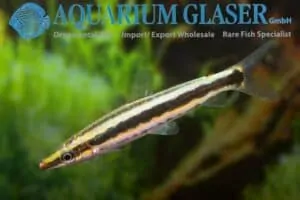Hemigrammus hyanuary – January Tetra
Hemigrammus hyanuary was described by Durbin in 1918. The genus name Hemigrammus comes from ancient Greek and can be broken into two parts. Hemi means ‘half’ and gramma means letter or signal. This is a reference to the lateral line breaking off abruptly halfway through. The species name hyanuary is a reference to Lake Hyanuary in Brazil, the type location of this species.
Their common name is January Tetra. This is a corruption of the name of the lake.
Description
De Groene Neon kan een totale lengte bereiken van maximaal zo’n 4,5 centimeter. Ze hebben een groenige kleur met over de zijlijn een luminiserende groene streep. Op de staartwortel bevindt zich aan de onderkant een zwarte vlek met daarboven een oplichtende groene stip. Het patroon lijkt op die van Hemigrammus ocellifer en in de handel worden ze dan ook soms met elkaar verward.
Hemigrammus hyanuary is a peaceful species that is best kept in a school.
The difference between the male and female can be seen in the size of the January Tetra. Males are somewhat smaller and slimmer than females. The Hemigrammus hyanuary male has a hook on the anal fin, which is missing in the females.

Biotope
The distribution area of the January Tetra is in the Amazon basin in Brazil and Peru. The type specimen was caught in Lake Hyanuary near the city of Manaus in Brazil.
They inhabit the slow-flowing rivers, streams and flood lakes. These streams and rivers contain little or no plants. The substrate consists mainly of sand and fallen leaves. Due to the decomposition of the leaves, the water has a darker colour.
Diet
In the wild, the diet of Hemigrammus hyanuary consists of small invertebrates such as worms, mosquito larvae, etc. In the aquarium, it is not a picky eater. You can feed the January Tetra with flake food, small granules, but also with small live or frozen food such as brine shrimp, daphnia, mosquito larvae and tubifex.

The Aquarium
An aquarium from about 60 centimeters is sufficient for only a small school of about eight Hemigrammus hyanuary. A larger school is nicer and more natural to see. Then you also need a somewhat larger aquarium.
Set up the aquarium with some (filter) sand on the bottom. Some driftwood or branches of suitable trees such as beech to imitate the biotope in which they live. Place some dried leaves on the bottom to give the water some color.
The January Tetra comes from somewhat darker colored water, the tannins released by the leaves automatically ensure that the water gets a light tea color. For the leaves you can just use some beech or oak leaves that you rinse and dry before use.
Plants are not immediately necessary for Hemigrammus hyanuary, but if you want to use plants, I would definitely do that.
Water parameters
The temperature of the water is preferably around 23 to 25 degrees Celsius. A slightly higher temperature is only required for breeding this species. The acidity of the water is preferably below pH 7, keep the pH between 6.0 and 7.0. The hardness of the water is not that important, it can be between 2 and 15.
Video
Author
John de Lange
Copyright images
References








Reviews
There are no reviews yet.